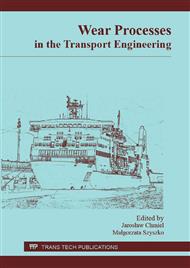[1]
I.W. Kragielskij: Trenije i iznos, Maszgiz, Moskwa (1962).
Google Scholar
[2]
M. Hebda, A. Wachal: Trybologia, WNT Warszawa (1980).
Google Scholar
[3]
R. Buczkowski, Statistical methods of rough surfaces and finite element contact analysis, 3/1999, Instytut Podstawowych Problemów Techniki PAN, Warszawa.
Google Scholar
[4]
R. Buczkowski and M. Kleiber, Statistical model of strongly anisotropic rough surfaces for finite element contact analysis, International Journal for Numerical Methods in Engineering, 49, 1169 – 1189 (2000).
DOI: 10.1002/1097-0207(20001130)49:9<1169::aid-nme994>3.0.co;2-j
Google Scholar
[5]
W. Zwierzycki (editor), Modele prognostyczne korozyjno-mechanicznego zużywania się elementów maszyn, Biblioteka Problemów Eksploatacji, Radom – Poznań (2002).
Google Scholar
[6]
J. Horabik, J. Laskowski (editors): Mechanical Properties of Granular Agro-Materials and Food Powders for Industrial Practice. Part I: M. Molenda, J. Horabik: Characterization of mechanical properties of particulate solids for storage and handling. 1-145, (2005).
Google Scholar
[7]
J. Horabik, M. Molenda: Acta Agrophysica, (2003), 93, 17-31.
Google Scholar
[8]
M. Stasiak, M. Molenda, J. Horabik: Moduls of elasticity of rapeseeds by edometric and acoustic methods. Electronic Journal of Polish Agricultural Universities, Vol. 9(4), 1-8, (2006).
Google Scholar
[9]
M. Jasiński: Master thesis, Maritime University of Szczecin, Faculty of Economics and Transport Engineering, (2006).
Google Scholar
[10]
J. Śmiechowski: Master thesis, Maritime University of Szczecin, Faculty of Economics and Transport Engineering, (2011).
Google Scholar
[11]
A. Stachowiak, W. Zwierzycki: An Analysis of the Tribocorrosion Wear by Means of Wear Maps, Solid State Phenomena, vol. 225 (2015), pp.95-100.
DOI: 10.4028/www.scientific.net/ssp.225.93
Google Scholar
[12]
M. Lukaszewicz M., Shen Gi Zhou, A. Turnbull: Novel Concepts on the Growth of Corrosion Fatigue Small and Short Cracks, Solid State Phenomena, vol. 227 (2015), p.3 – 6.
DOI: 10.4028/www.scientific.net/ssp.227.3
Google Scholar
[13]
J. Michalska: Microbial Aspects in Corrosion Studies of Stainless Steels, Solid State Phenomena, vol. 183 (2012), p.117 – 124.
DOI: 10.4028/www.scientific.net/ssp.183.117
Google Scholar
[14]
J. Chmiel, R. Jasionowski, D. Zasada: Cavitation Erosion and Corrosion of Pearlitic Gray Cast Iron in Non-Standardized Cavitation Conditions, Solid State Phenomena Vol. 225 (2015) p.19 – 24.
DOI: 10.4028/www.scientific.net/ssp.225.19
Google Scholar


